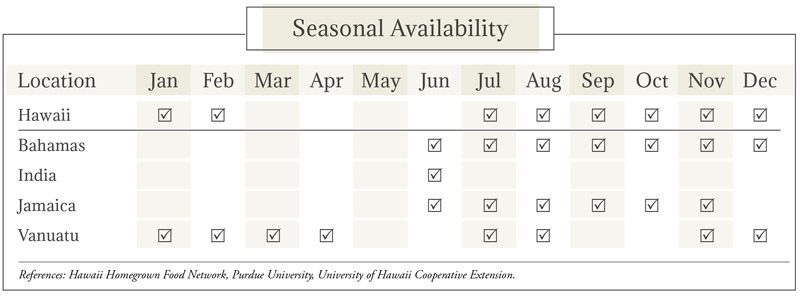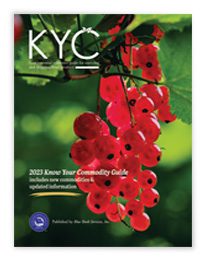Breadfruit Market Summary


Image: ChameleonsEye/Shutterstock.com
Breadfruit Market Overview
Grown as a staple crop in the Pacific Islands and across the tropics for millennia, breadfruit, or Artocarpus altilis, is a member of the Moeaceae or mulberry family. Identified as a valuable crop by early colonists and explorers to the Pacific, breadfruit was collected and shipped to the Caribbean as a plantation food source. Breadfruit now grows in 90 countries worldwide. Extremely versatile, breadfruit is consumed fresh, processed, frozen, or fermented, and can be used as animal feed. Green breadfruit is consumed as a vegetable, while fully ripened yellow breadfruit is eaten as a fruit, often in desserts. The tree is useful in preventing soil erosion and as a support for climbing crops. It also provides compostable leaves and timber, and shade from its broad canopy. Breadfruit is becoming more popular as a gluten- and cholesterol-free starch. The flesh is high in complex carbohydrates and low in fat with some carotenoids, providing more nutrients than white rice, potatoes, bread, or taro root.
Types & Varieties of Breadfruit
Within the South Pacific, there are up to 200 varieties of breadfruit, mostly held in local indigenous knowledge. Varieties may be few-seeded or unseeded. Seeded varieties should not be confused with the related but different breadnut tree. For domestic production in the United States, specifically Hawaii, there are three main cultivars, Ma’afala, ‘Ula, and Meinpadahk. Ma’afala is a fast-growing variety from Samoa, known for shorter, more compact trees and the smallest fruit. ’Ulu was a canoe crop brought to Hawaii by Polynesians, the fruit features rougher skin with dried sap, more pronounced scabbing, and an average weight of over 4 pounds. The Meinpadahk variety is a natural hybrid between A. altilis and A. mariannensis, with a bright, waxy green skin on the fruit, which doesn’t develop scabbing or crusting upon ripening.

The Cultivation of Breadfruit
Breadfruit trees can stand as high as 85 feet with a broad, thick canopy beginning after about 20 feet. It is recommended to plant breadfruit with cover crops and mulch to maintain soil moisture. Depending on climate, leaves can be evergreen or deciduous, from 9 to as long as 36 inches, with pointed lobes in a bright waxy green color. The tree grows best in hot, humid, tropical lowlands; even Florida’s mild winters have been known to damage and weaken trees. There are some growers in South Florida, but supply is very limited. The breadfruit is a syncarp, and typically oblong with a diameter up to 12 inches. Ripe breadfruit will have relatively smooth, greenish skin with brown cracking between the lighter surface segments and small drops of latex on the surface (depending on variety). Fruit is susceptible to sunburn at particular times of the year, though the tree’s canopy can help reduce the risk. In the Pacific, fruit is harvested by climbing the tree and breaking the fruit off with a forked stick, then packing into sectioned cartons. Breadfruit is thought to be one of the most productive trees in the world, providing anywhere from 50 to 200 fruits per year depending on location. A ripe breadfruit will have firm light yellow or whitish colored flesh, unless left to ripen further, in which case the flesh will become soft and mushy.
Pests & Diseases Affecting Breadfruit
Although breadfruit is valued for having few serious pests and diseases, the following may still affect the trees. Soft-scale and mealybugs are known to cause damage in the Caribbean and Pacific, especially if trees are already weakened due to drought or neglect. Ants and scale may be present but are not considered high risk, usually causing only minor damage. Fruit flies can be a problem for fresh fruit exports, requiring postharvest prevention treatment. Soft rot afflicts trees in India, but the fungal disease can be controlled by careful spraying. Fusarium, phytophthora, and anthracnose can be avoided by maintaining air circulation and debris removal, especially fallen fruit.Storage & Packaging of Breadfruit
Breadfruit can be stored underwater (as it is in Jamaica) or in storage at 54 to 58°F for 2 to 4 weeks with 85 to 95% relative humidity. The ripening process will be accelerated by exposure to ethylene for 24 hours at 68°F, but ultimately shortening shelf life. Modified atmosphere packaging can help delay ripening of mature green (not ripe, yellow) breadfruit when maintaining standard temperatures and humidity. Breadfruit is prone to chilling injury, especially if kept below 54°F, manifesting as brown skin discoloration, increased decay, and pulp browning. References: Hawaii Homegrown Food Network, Purdue University, UC Davis Postharvest Technology website, University of Hawaii Cooperative Extension.Grades & Good Arrival of Breadfruit
There is no grade information for breadfruit at this time. Currently, there are no good arrival guidelines published for this commodity.Breadfruit Terminal Market Pricing: 40 lb. Cartons



